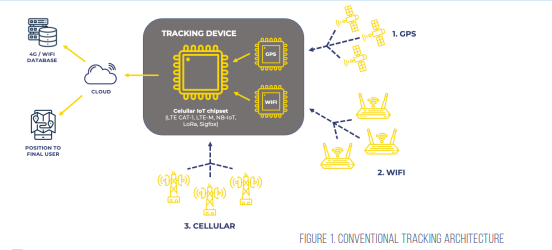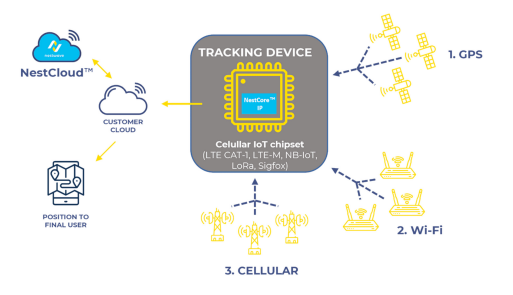Minimising power budgets for IoT Geolocation
What are the challenges for integrating accurate geolocation into compact, battery powered, low-cost IoT nodes, asks Ambroise Popper, CEO, Nestwave.
This article originally appeared in the Oct'22 magazine issue of Electronic Specifier Design – see ES's Magazine Archives for more featured publications.
To drive growth in IoT-based asset tracking, new approaches are needed to minimise power consumption, size and cost.
Figure 1 illustrates a typical tracking device architecture based around an LPWA (low-power, wide area) modem chip with LTE-M, NB-IoT, LoRa or Sigfox functionality for connectivity to the cellular network. Cellular location is low cost but provides poor accuracy, so the LPWA device is combined with a GPS chip, for outdoors and a Wi-Fi chip for indoor location accuracy. The tracking device communicates with the cloud, which, in turn, takes relevant data from 4G and Wi-Fi databases before delivering position information to the user.
Conventional ‘consumer-oriented’ geolocation architectures in IoT tracking applications are power hungry due to a number of factors, including the energy consumption of the GPS chip, how position is calculated and, in particular, the energy required per position fix.
In the traditional architecture of Figure 1, the tracking device opens up the GPS receiver and scans and searches for satellite signals. Once acquired, there is a period of fine-tuning and tracking before location is fixed. Almanacs and ephemeris data (parameters that can be used to calculate the location of a satellite at a specific moment in time) from each satellite are decoded and the process can take tens of seconds and up to more than a minute. The longer it takes, the higher the energy consumed.
Versatile IP
Significant power reductions could be realised by eliminating the external GPS device and minimising the time taken to obtain a position fix. One solution is to deploy IP that implements a GPS receiver running on the existing IoT modem chip. NestWave’s NestCore IP, for example, uses local device resources for tasks that require very fast, high resolution processing and offloads some of the more complex, en[1]ergy-intensive computation to the cloud (Figure 2). The IP power requirement is Figure 1. Conventional tracking architecture POWER: IOT DESIGN 27 ELECTRONICSPECIFIER.COM kept low by reducing the active time of the IoT chipset. There is also high sensitivity reception for urban canyon and indoor coverage, small memory area and, importantly, fast time-to[1]first-fix (TTFF).
TTFF is minimised by reducing the number of operations to lock on to signals, store ephemeris data in the cloud and apply signal processing operations to information captured to determine time of arrival of wireless positioning signals. This removes the need for continuous receiver operation while ensuring location fixes with equivalent accuracy to conventional methods but with just one-tenth the processing period. Compared to a traditional approach, this fast fix reduces GPS power by a factor of 10 and, depending on implementation, can improve the battery life of an IoT tracking device by up to four times.
The number of fixes that an IoT node has to make will also have a significant impact on power consumption. The good news is that the majority of IoT applications rarely need to provide continuous location information and in many cases, the number of fixes can be reduced to one a week or even one a month.
For example, when tracking and recovering lost or stolen property, such as a bike, six fixes a day would be adequate to deliver the location information needed and a single 200mAh battery could power the IoT device for several years. Other applications, such as locating pallets or crates, would reduce the number of fixes to just a few a month.
Practical implementation
Employing geolocation IP on the modem chipset also reduces overall form factor, bill of materials and cost of implementation.
Working with IoT connectivity specialist, Samea, NestWave created ThinTrack, a re-usable tracker for letters and parcels (Figure 3).
The low-profile IoT tracker reference design integrates an LTE-M/NB-IoT modem, antenna, battery, SIM and all necessary electronics in a 82 x 35 x 3.0mm form factor and weighs only 13g. It can be inserted into envelopes or the plastic pouches used for shipping documentation and operates from a single 150mAh Li-Ion battery for over a year.













